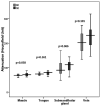Image quality and radiation dose of dual-energy CT of the head and neck compared with a standard 120-kVp acquisition
- PMID: 21903909
- PMCID: PMC7964383
- DOI: 10.3174/ajnr.A2654
Image quality and radiation dose of dual-energy CT of the head and neck compared with a standard 120-kVp acquisition
Abstract
Background and purpose: DECT offers additional image datasets with potential benefits, but its use for H&N imaging is not justified unless image quality is preserved without increased radiation dose. The aim of this work was to compare image quality and radiation dose between a DE-derived WA image dataset and a standard SECT acquisition of the H&N.
Materials and methods: Thirty-two patients underwent DECT of the H&N (tube voltages 80 and Sn140 kVp) and were compared with the last 32 patients who underwent standard SECT (120 kVp) on the same dual-source scanner. WA images from the 2 DE tubes were compared with images obtained with an SE mode. Radiation doses and attenuation measurements of the internal jugular vein, submandibular gland, and sternomastoid and tongue muscles were compared. Objective image noise was compared at 5 anatomic levels. Two blinded readers compared subjective image quality by using 5-point grading scales.
Results: CTDI(vol) was 12% lower with DE than with SECT, a difference of 1.5 mGy, (P < .0001). Objective noise was not significantly different between DE and SECT at any of the anatomic levels (P > .05). No significant differences in attenuation measurements were observed between DE and SECT (P > .05). No significant differences in subjective image quality scores were observed between DE and SECT at any of the 5 anatomic levels (P > .05).
Conclusions: DE-derived WA images of the H&N are equivalent to standard SE acquisitions and thus can be used for routine diagnostic purposes. Multiple additional image datasets can be obtained with no radiation dose penalty.
Figures



Similar articles
-
Head and neck single- and dual-energy CT: differences in radiation dose and image quality of 2nd and 3rd generation dual-source CT.Br J Radiol. 2021 Jun 1;94(1122):20210069. doi: 10.1259/bjr.20210069. Epub 2021 Apr 29. Br J Radiol. 2021. PMID: 33914613 Free PMC article.
-
Third generation dual-energy CT with 80/150 Sn kV for head and neck tumor imaging.Acta Radiol. 2019 May;60(5):586-592. doi: 10.1177/0284185118788896. Epub 2018 Aug 8. Acta Radiol. 2019. PMID: 30089396
-
Dual-energy CT of head and neck cancer: average weighting of low- and high-voltage acquisitions to improve lesion delineation and image quality-initial clinical experience.Invest Radiol. 2012 May;47(5):306-11. doi: 10.1097/RLI.0b013e31821e3062. Invest Radiol. 2012. PMID: 21577123
-
Dual-energy, standard and low-kVp contrast-enhanced CT-cholangiography: a comparative analysis of image quality and radiation exposure.Eur J Radiol. 2012 Jul;81(7):1405-12. doi: 10.1016/j.ejrad.2011.03.030. Epub 2011 Apr 2. Eur J Radiol. 2012. PMID: 21458939
-
Task-based measures of image quality and their relation to radiation dose and patient risk.Phys Med Biol. 2015 Jan 21;60(2):R1-75. doi: 10.1088/0031-9155/60/2/R1. Epub 2015 Jan 7. Phys Med Biol. 2015. PMID: 25564960 Free PMC article. Review.
Cited by
-
Value of virtual monochromatic spectral images with metal artifact reduction algorithm in dual-energy computed tomography-guided microcoil localization of pulmonary nodules.Medicine (Baltimore). 2018 Jul;97(29):e11562. doi: 10.1097/MD.0000000000011562. Medicine (Baltimore). 2018. PMID: 30024555 Free PMC article.
-
Comparison of tumor delineation using dual energy computed tomography versus magnetic resonance imaging in head and neck cancer re-irradiation cases.Phys Imaging Radiat Oncol. 2020 Apr 29;14:1-5. doi: 10.1016/j.phro.2020.04.001. eCollection 2020 Apr. Phys Imaging Radiat Oncol. 2020. PMID: 33458306 Free PMC article.
-
Dual-energy 4-phase CT scan in primary hyperparathyroidism.AJNR Am J Neuroradiol. 2013 Aug;34(8):E91-3. doi: 10.3174/ajnr.A3657. Epub 2013 Jun 20. AJNR Am J Neuroradiol. 2013. PMID: 23788604 Free PMC article. No abstract available.
-
Inter-Observer Agreement of Whole-Body Computed Tomography in Staging and Response Assessment in Lymphoma: The Lugano Classification.Pol J Radiol. 2017 Aug 23;82:441-447. doi: 10.12659/PJR.902370. eCollection 2017. Pol J Radiol. 2017. PMID: 29662570 Free PMC article.
-
Advanced virtual monochromatic reconstruction of dual-energy unenhanced brain computed tomography in children: comparison of image quality against standard mono-energetic images and conventional polychromatic computed tomography.Pediatr Radiol. 2017 Nov;47(12):1648-1658. doi: 10.1007/s00247-017-3908-8. Epub 2017 Jun 27. Pediatr Radiol. 2017. PMID: 28656326
References
-
- Kang MJ, Park CM, Lee CH, et al. . Dual-energy CT: clinical applications in various pulmonary diseases. Radiographics 2010;30:685–98 - PubMed
-
- Johnson TR, Krauss B, Sedlmair M, et al. . Material differentiation by dual energy CT: initial experience. Eur Radiol 2007;17:1510–17 - PubMed
-
- Stolzmann P, Leschka S, Scheffel H, et al. . Characterization of urinary stones with dual-energy CT: improved differentiation using a tin filter. Invest Radiol 2010;45:1–6 - PubMed
-
- Thieme SF, Johnson TR, Lee C, et al. . Dual-energy CT for the assessment of contrast material distribution in the pulmonary parenchyma. AJR Am J Roentgenol 2009;193:144–49 - PubMed
-
- Morhard D, Fink C, Graser A, et al. . Cervical and cranial computed tomographic angiography with automated bone removal: dual energy computed tomography versus standard computed tomography. Invest Radiol 2009;44:293–97 - PubMed
Publication types
MeSH terms
LinkOut - more resources
Full Text Sources
Medical
